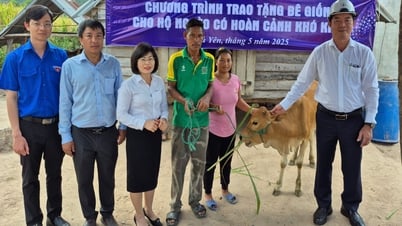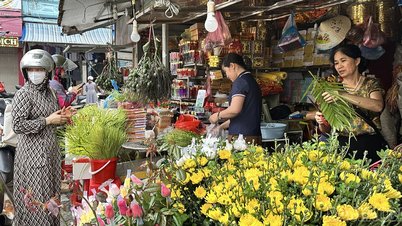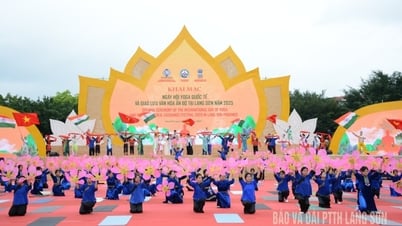In recent years, Lam Dong's agricultural sector has promoted the comparative advantages of mulberry and silkworms, linking production with market demand, bringing economic efficiency many times higher than cultivating industrial crops such as tea, coffee, pepper, cashew...
 |
| Lam Dong silk processing industry accounts for 80% of the country's output. |
• RAISE 350,000 - 400,000 SILKWORM BOXES EACH YEAR
According to statistics in 2023, Lam Dong province has about 16,000 farming households, 5 craft villages, 45 cooperatives, 12 cooperatives growing mulberry and raising silkworms with a total area of about 9,800 hectares, mulberry leaf output is estimated at 247,000 tons, equivalent to 16,000 tons of cocoons, and over 2,000 tons of silk thread. In particular, focusing on producing mulberry seed sources suitable for land and climate conditions, with high productivity and quality, meeting the silkworm raising needs of agricultural areas in the province, including: S7-CB, VA-201, TBL-03, TBL-05. The province currently has 4 organizations and individuals importing bisexual silkworm eggs from China and about 200 silkworm breeding facilities concentrated in Lam Ha district and Bao Loc city, supplying silkworms according to plan for breeders, an average of about 350,000 - 400,000 boxes/year, with a total value of about 100 billion VND.
Continuing to improve the efficiency of mulberry cultivation and silkworm rearing, in the period of 2019-2023, Lam Dong Department of Agriculture organized training on management processes and techniques for mulberry cultivation and silkworm rearing for 26 officials in charge of and managing the mulberry and silkworm industry of the province and localities; organized 20 training courses to transfer technical processes for mulberry cultivation and silkworm rearing to 800 farmers in the area. In addition, integrating funds from programs and projects, Lam Dong Department of Agriculture organized 25 more training courses for 1,250 farmers to access the process of mulberry cultivation, silkworm rearing, and prevention of nematodes that harm mulberry; conducted 3 trials and models to identify effective drugs to prevent nematodes that harm mulberry in Lam Ha and Da Teh; built mulberry cultivation and silkworm rearing models with an area of 10 hectares of mulberry and supported 500 boxes of dual-system silkworms in the whole province.
“Through training courses, technical advances have been transferred to farmers and widely applied in production, disease prevention for mulberry trees and silkworms has been well implemented, mulberry and silkworm varieties have been selected suitable for each region's conditions, methods of managing mulberry cultivation and silkworm rearing have been innovated; cooperatives and enterprises have strengthened the management of production chains associated with the consumption of silkworm cocoons, contributing to economic efficiency and sustainable development of mulberry cultivation and silkworm rearing in the locality...”, Lam Dong Department of Agriculture commented.
• TOTAL EXPORT TURNOVER REACHED ABOUT 180 MILLION USD
The province currently has about 32 establishments with over 100 automatic silk reeling rows, 400 threads/row, the quality of silk has been improved to meet the requirements of the domestic market and export. The textile industry produces over 5 million meters of raw silk/year, with a sewing capacity of about 200,000 products/year. The silk product processing industry annually employs over 2,000 workers, equivalent to 60 - 80 workers/establishment. Up to now, the province has developed 12 production chains associated with the consumption of silk products, including 4 provincial-level chains and 8 district-level chains with more than 630 participating households.
Production is linked to the consumption market, the whole Lam Dong province exported about 1,800 tons of Lam Dong silk last year, bringing the total export turnover of silk, textile yarn, and fabrics of all kinds to about 180 million USD. Typical enterprises purchasing, producing and exporting silk in the province include: Bao Loc Silk Joint Stock Company; Silk Production, Trading and Import-Export Joint Stock Company; Viet Silk Silk Weaving Company Limited, Chau A Production, Trade and Investment Company Limited; Ha Bao Silk Sewing and Weaving Company Limited; Giang Ngoc Company Limited... The export market of fiber and raw silk of Vietnam in general and Lam Dong in particular is to China, India, Korea, Bangladesh, Taiwan. Currently, more than 70% of Vietnam's yarn industry output is exported to China, accounting for 55% of the export turnover. The export market of woven fabrics from silk or silk scrap is exported to Japan, India, Korea, China, Brunei...
The results for the whole year of 2023, the value of mulberry growing and silkworm farming area in Lam Dong province is on average about 350 - 400 million VND/ha/year, the profit is about 50% of the revenue. This is a fairly high profit ratio compared to the initial investment capital, fast capital turnover, 2-3 times higher than the same area of cultivating long-term industrial crops such as: coffee, tea, pepper, cashew. If compared to the whole country, Lam Dong's mulberry area currently accounts for about 70%, silk output is over 80%. In the coming time, Lam Dong's agricultural sector "encourages the development of linkages between mulberry growing and silkworm farming households, input material supply enterprises and silk reeling and weaving factories associated with the development of raw material areas to ensure sustainability, increase value, and efficiency in the production chain...".
Source


![[Photo] National Conference "100 years of Vietnamese Revolutionary Press accompanying the glorious cause of the Party and the nation"](https://vphoto.vietnam.vn/thumb/1200x675/vietnam/resource/IMAGE/2025/5/30/1cf6cd5c8a934ebfa347028dcb08358c)
![[Photo] General Secretary To Lam receives Chief of the Central Office of the Lao People's Revolutionary Party](https://vphoto.vietnam.vn/thumb/1200x675/vietnam/resource/IMAGE/2025/5/30/140435f4b39d4599a3d17975dfb444c5)

































![[Photo] Journalists moved to tears at the Memorial Service for the soldiers who died in Gac Ma](https://vphoto.vietnam.vn/thumb/1200x675/vietnam/resource/IMAGE/2025/5/30/9454613a55c54c16bf8c0efa51883456)































































Comment (0)